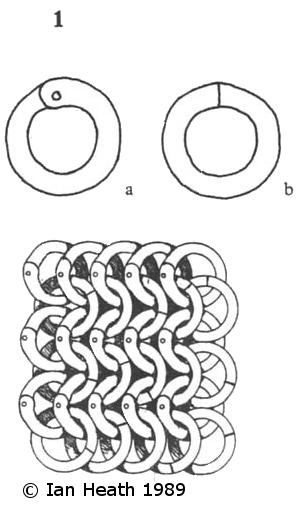|
Download 2 free e-books from Amazon Audible | by Ian Heath  1. MAIL The fact that mediaeval artists used a variety of techniques to illustrate mail has led several authorities - starting with Sir Samuel Rush Meyrick back in 1820, and continuing right up to modern times (eg, F. Buttin in 1971)- to assume, and even try to prove, that there was more than one type of mail, often thereby showing an apparent ignorance of or disregard for the existence in mediaeval times of other forms of body-armour such as lamellar, quilt or scale; even Contamine, in his recent War in the Middle Ages, seems guilty of this, writing only that 'we cannot exclude the possibility that in the High Middle Ages use was sometimes made of armour made from little scales or strips (lames) of metal.' Meyrick, who applied detailed consideration and considerable imagination to the problem, has left us with terms such as 'trellissed', 'banded', 'mascled', etc, which, though usually rejected by serious authorities, are still repeated by many historians even today. To date, however, only one pattern of actual mail has been discovered anywhere, and that is the interlocking ring with its ends either butted or riveted together. The patterns on which Meyrick based his impractical theories certainly exist in contemporary pictorial sources, but in general they are merely the alternative techniques of different artists who either: (a) followed a recognised convention or style for illustrating mail; (b) sacrificed detail for speed and simplicity; (c) intended to represent an entirely different type of armour, such as pourpoint, rivets, scales or lamellae (where, for instance, a single artist has used more than one technique (there is every chance that he intended to represent more than one of these types of armour in addition to actual mail); or (d) firmly believed that the particular pattern they were using adequately represented mail (in this they were quite obviously under a misapprehension). There is, by the way, no such thing as 'chain-mail', this rather misleading term first being coined only in the mid-18th century. |
Next: 2. KNIGHT c.1100 in Armies of Feudal Europe 1066-1300, by Ian Heath
